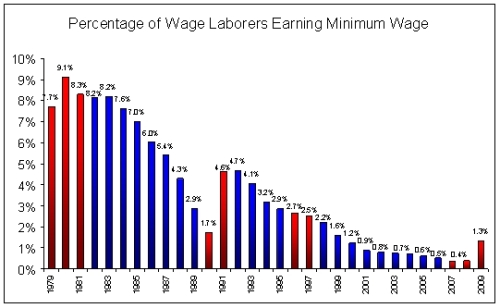Working against workers
Misguided policies are driving up unemployment in Nevada
- Wednesday, July 28, 2010
Nevada — with its 14.2 percent, highest-in-the-nation unemployment rate in June — is suffering the consequences of politically appealing but thoroughly misguided state and federal public policies.
For 53 months straight, unemployment in Nevada has risen. The state has not seen an actual decrease in unemployment since January 2006. While the rest of the nation was watching unemployment rates drop since December 2009, more than 15,000 Nevadans were added to unemployment rolls.
At the federal level, bad and corrupt policy not only precipitated the financial meltdown, but growing evidence suggests that Bush/Obama-administration stimulus funds are prolonging the recession — and especially so, here in the Silver State.
Nevada's political leaders have only made the situation worse. The legislature kicked Nevadans while they were down with, yet again, a massive tax increase in 2009. Legislative leaders have also virtually destroyed what little economic confidence remained in the state by repeatedly talking up more tax increases and spending $250,000 on a dubious study to justify their hunger for a corporate income tax.
Nevada voters don't escape responsibility, either. They put a thoroughly destructive minimum-wage law in the state constitution by a voter initiative in 2006. Thus on July 1 of this year the state minimum wage increased to $8.25 an hour for laborers without health insurance.
Siding with demagogues and ignoring wiser counsel, voters no doubt believed they were helping low-income workers earn a higher wage. But in reality, minimum-wage laws mandate fewer job opportunities for low-skilled workers. Nobel Prize-winning economist Milton Friedman nailed it when he called the minimum wage "a law that is most properly described as: employers must discriminate against people with low skills."
Many people incorrectly believe that government has to increase the minimum wage because corporations won't increase wages on their own. The reality, however, is different: From 1997 to 2007 — a decade when no federal minimum-wage law was enacted — the number of laborers earning at or below the minimum wage fell by 3 million, while the U.S. labor force over that period grew by 5 million. As economists knew would happen, employers, to attract labor, boosted prevailing wages.

*Red bars are years in which the minimum wage was increased.
It is job experience — becoming more skilled and productive — that allows minimum-wage laborers to move up the pay scale. In fact, says the Employment Policy Institute, 65 percent of minimum-wage workers earn a pay increase within their first year.
But who are these minimum-wage laborers?
Today, more than half of minimum-wage earners are 25 years or younger, even though those young workers make up just 20 percent of the labor force. These figures tend to remain constant over time. This means raising the minimum wage disproportionally impacts young workers.
Overall, minimum-wage workers also are likely to be unmarried and work part-time. Most of them are in industries where tips supplement their income (making it higher than the federal minimum). Finally, just a third of workers earning $8.25 or less are their households' primary income earners.
All of this suggests the minimum wage is an ineffective tool for combating poverty. Most economists still agree that raising the minimum wage results in more unemployment. And contrary to claims that increasing the minimum wage can increase consumption and boost the economy, the Federal Reserve Bank of Minneapolis found "[a] modest increase in the minimum would certainly lift some households on the margin out of poverty. However, other households above the poverty line may be plunged below it if the higher wage causes them to lose their jobs. Even a minimal decrease in employment could wipe out aggregate income gains from a higher minimum wage."
Since most minimum-wage workers are young, and raising the minimum wage increases unemployment among workers with fewer skills, we can expect to see young people disproportionately unemployed. Sure enough, overall unemployment in June averaged 9.5 percent nationally, but was 25.7 percent among teenagers.
For racial minorities, unemployment is worse still. White teenagers averaged a 23.3 percent unemployment rate in June, while 39.9 percent of African-American teenagers and 35.7 percent of Hispanic teens remain unemployed. And of course, the disparity by race in unemployment persists among adults:
|
White |
Black |
Hispanic |
Asian |
|
8.6% |
15.4% |
12.4% |
7.7%* |
Source: Bureau of Labor Statistics http://www.bls.gov/news.release/empsit.t02.htm, http://www.bls.gov/news.release/empsit.t03.htm *Not seasonally adjusted.
There is no doubt that Nevada's minimum-wage law contributes to unemployment and has an especially discriminatory impact on teenagers, African-Americans and Hispanics in the Silver State.
Repealing the misguided constitutional amendment as quickly as possible would reduce those disparities while boosting Nevada's economy.
Patrick R. Gibbons is an education policy analyst at the Nevada Policy Research Institute. For more information visit http://npri.org/.





